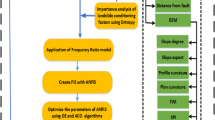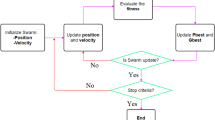Abstract
The scouring phenomenon is one of the major problems experienced in hydraulic engineering. In this study, an adaptive neuro-fuzzy inference system is hybridized with several evolutionary approaches, including the ant colony optimization, genetic algorithm, teaching-learning-based optimization, biogeographical-based optimization, and invasive weed optimization for estimating the long contraction scour depth. The proposed hybrid models are built using non-dimensional information collected from previous studies. The proposed hybrid intelligent models are evaluated using several statistical performance metrics and graphical presentations. Besides, the uncertainty of models, variables, and data are inspected. Based on the achieved modeling results, adaptive neuro-fuzzy inference system-biogeographic based optimization (ANFIS-BBO) provides superior prediction accuracy compared to others, with a maximum correlation coefficient (Rtest = 0.923) and minimum root mean square error value (RMSEtest = 0.0193). Thus, the proposed ANFIS-BBO is a capable cost-effective method for predicting long contraction scouring, thus, contributing to the base knowledge of hydraulic structure sustainability.
Similar content being viewed by others
References
Straub L G. Effect of channel-contraction works upon regimen of movable bed-streams. Eos (Washington, D.C.), 1934, 15: 454–163
Laursen E M. An analysis of relief bridge scour. Journal of the Hydraulics Division, 1963, 89(3): 93–118
Hong S H, Abid I. Physical model study of bridge contraction scour. KSCE Journal of Civil Engineering, 2016, 20(6): 2578–2585
Komura S. Equilibrium depth of scour in long constrictions. Journal of the Hydraulics Division, 1966, 92(5): 17–37
Gill M A. Bed erosion in rectangular long contraction. Journal of the Hydraulics Division, 1981, 107(3): 273–284
Lim S Y, Lim S. Clear water scour in long contractions. Water, Maritime and Energy, 1993, 101(2): 93–98
Arneson L A, Abt S R. Vertical contraction scour at bridges with water flowing under pressure conditions. Transportation Research Record: Journal of the Transportation Research Board, 1998, 1647(1): 10–17
Umbrell E R, Young G K, Stein S M, Jones J S. Clear-water contraction scour under bridges in pressure flow. Journal of Hydraulic Engineering (New York, N.Y.), 1998, 124(2): 236–240
Dey S, Sarkar A. Scour downstream of an apron due to submerged horizontal jets. Journal of Hydraulic Engineering (New York, N.Y.), 2006, 132(3): 246–257
Hong S H. Interaction of bridge contraction scour and pier scour in a laboratory river model. Dissertation for the Doctoral Degree. Atlanta: Georgia Institute of Technology, 2005
Ghazvinei P T, Ariffin J, Mohammad T A, Amini S A, Aghajani Mir M, Saheri S, Ansarimoghaddam S. Contraction scour analysis at protruding bridge abutments. Proceedings of the Institution of Civil Engineers-Bridge Engineering, 2015, 169(1): 39–53
Sharafati A, Haghbin M, Motta D, Yaseen Z M. The application of soft computing models and empirical formulations for hydraulic structure scouring depth simulation: A comprehensive review, assessment and possible future research direction. Archives of Computational Methods in Engineering, 2021, 28(2): 423–447
Jiang J, Ganju N K, Mehta A J. Estimation of contraction scour in riverbed using SERF. Journal of Waterway, Port, Coastal, and Ocean Engineering, 2004, 130(4): 215–218
Briaud J L, Chen H C, Li Y, Nurtjahyo P, Wang J. SRICOS-EFA method for contraction scour in fine-grained soils. Journal of Geotechnical and Geoenvironmental Engineering, 2005, 131(10): 1283–1294
Duc B M, Rodi W. Numerical simulation of contraction scour in an open laboratory channel. Journal of Hydraulic Engineering (New York, N.Y.), 2008, 134(4): 367–377
Straub T D, Over T M. Pier and Contraction Scour Prediction in Cohesive Soils at Selected Bridges in Illinois. 2010 (Available at the website of IDEALS)
Hamdia K M, Ghasemi H, Bazi Y, AlHichri H, Alajlan N, Rabczuk T. A novel deep learning based method for the computational material design of flexoelectric nanostructures with topology optimization. Finite Elements in Analysis and Design, 2019, 165: 21–30
Hamdia K M, Lahmer T, Nguyen-Thoi T, Rabczuk T. Predicting the fracture toughness of PNCs: A stochastic approach based on ANN and ANFIS. Computational Materials Science, 2015, 102: 304–313
Mohammed M, Sharafati A, Al-Ansari N, Yaseen Z M. Shallow foundation settlement quantification: Application of hybridized adaptive neuro-fuzzy inference system model. Advances in Civil Engineering, 2020, 2020: 7381617
Azamathulla H M. Neural networks to estimate scour downstream of ski-jump bucket spillway. Dissertation for the Doctoral Degree. Bombay: Indian Institute of Technology, 2005
Azamathulla H M, Ab Ghani A, Azazi Zakaria N. Prediction of scour below flip bucket using soft computing techniques. In: Proceedings of the AIP Conference. Hong Kong, Macao, China: AIP Conference Proceedings, 2010
Guven A, Azamathulla H M, Zakaria N A. Linear genetic programming for prediction of circular pile scour. Ocean Engineering, 2009, 36(12–13): 985–991
Najafzadeh M, Barani G A, Hessami Kermani M R. GMDH based back propagation algorithm to predict abutment scour in cohesive soils. Ocean Engineering, 2013, 59: 100–106
Sharafati A, Yasa R, Azamathulla H M. Assessment of stochastic approaches in prediction of wave-induced pipeline scour depth. Journal of Pipeline Systems Engineering and Practice, 2018, 9(4): 04018024
Bateni S M, Jeng D S, Melville B W. Bayesian neural networks for prediction of equilibrium and time-dependent scour depth around bridge piers. Advances in Engineering Software, 2007, 38(2): 102–111
Ayoubloo M K, Azamathulla H M, Ahmad Z, Ghani A A, Mahjoobi J, Rasekh A. Prediction of scour depth in downstream of ski-jump spillways using soft computing techniques. International Journal of Computers and Applications, 2011, 33(1): 92–97
Najafzadeh M, Barani G A, Hessami-Kermani M R. Group method of data handling to predict scour depth around vertical piles under regular waves. Scientia Iranica, 2013, 20(3): 406–413
Najafzadeh M, Barani G A, Hessami Kermani M R. Estimation of Pipeline Scour due to Waves by GMDH. Journal of Pipeline Systems Engineering and Practice, 2014, 5(3):1–5
Firat M. Scour depth prediction at bridge piers by ANFIS approach. Proceedings of the Institution of Civil Engineers-Water Management, 2009, 162(4): 279–288
Jang J S. ANFIS: adaptive-network-based fuzzy inference system. IEEE Transactions on Systems, Man, and Cybernetics, 1993, 23(3): 665–685
Mohammadpour R, Ghani A A, Azamathulla H M. Estimation of dimension and time variation of local scour at short abutment. International Journal of River Basin Management, 2013, 11(1): 121–135.
Khozani Z S, Khosravi K, Torabi M, Mosavi A, Rezaei B, Rabczuk T. Shear stress distribution prediction in symmetric compound channels using data mining and machine learning models. 2019, arXiv:2001.01558
Bateni S M, Borghei S M, Jeng D S. Neural network and neurofuzzy assessments for scour depth around bridge piers. Engineering Applications of Artificial Intelligence, 2007, 20(3): 401–414
Sharafati A, Haghbin M, Haji Seyed Asadollah S B, Tiwari N K, Al-Ansari N, Yaseen Z M. Scouring depth assessment downstream of weirs using hybrid intelligence models. Applied Sciences (Basel, Switzerland), 2020, 10(11): 3714
Zounemat-Kermani M, Beheshti A A, Ataie-Ashtiani B, Sabbagh-Yazdi S R. Estimation of current-induced scour depth around pile groups using neural network and adaptive neuro-fuzzy inference system. Applied Soft Computing, 2009, 9(2): 746–755
Azamathulla H M, Ghani A A, Zakaria N A. ANFIS-based approach to predicting scour location of spillway. Proceedings of the Institution of Civil Engineers-Water Management, 2009, 162(6):399–407
Farhoudi J, Hosseini S M, Sedghi-Asl M. Application of neurofuzzy model to estimate the characteristics of local scour downstream of stilling basins. Journal of Hydroinformatics, 2010, 12(2): 201–211
Keshavarzi A, Gazni R, Homayoon S R. Prediction of scouring around an arch-shaped bed sill using Neuro-Fuzzy model. Applied Soft Computing, 2012, 12(1): 486–493.
Cheng M Y, Cao M T. Hybrid intelligent inference model for enhancing prediction accuracy of scour depth around bridge piers. Structure and Infrastructure Engineering, 2015, 11(9): 1178–1189
Yaseen Z, Ebtehaj I, Kim S, Sanikhani H, Asadi H, Ghareb M, Bonakdari H, Wan Mohtar W, Al-Ansari N, Shahid S. Novel hybrid data-intelligence model for forecasting monthly rainfall with uncertaintyanalysis. Water (Basel), 2019, 11(3): 502
Sharafati A, Tafarojnoruz A, Shourian M, Yaseen Z M. Simulation of the depth scouring downstream sluice gate: The validation of newly developed data-intelligent models. Journal of Hydroenvironment Research, 2020, 29: 20–30
Raikar R V, Wang C Y, Shih H P, Hong J H. Prediction of contraction scour using ANN and GA. Flow Measurement and Instrumentation, 2016, 50: 26–34
Najafzadeh M, Etemad-Shahidi A, Lim S Y. Scour prediction in long contractions using ANFIS and SVM. Ocean Engineering, 2016, 111: 128–135
Dey S, Raikar R V. Scour in long contractions. Journal of Hydraulic Engineering (New York, N.Y.), 2005, 131(12): 1036–1049
Webby M G. General scour at contraction. Road Research Unit Bulletin, 1984, 73: 109–118
Lim S Y, Cheng N S. Scouring in long contractions. Journal of Irrigation and Drainage Engineering, 1998, 124(5): 258–261
Najafzadeh M, Shiri J, Rezaie-Balf M. New expression-based models to estimate scour depth at clear water conditions in rectangular channels. Marine Georesources & Geotechnology, 2018, 36(2): 227–235
Sharafati A, Haghbin M, Asadollah S B H S, Tiwari N K, Al-Ansari N, Yaseen Z M. Scouring depth assessment downstream of weirs using hybrid intelligence models. Applied Sciences (Basel, Switzerland), 2020, 10(11): 3714
Dorigo M. Optimization, learning and natural algorithms. Dissertation for the Doctoral Degree. Milano: Politecnico di Milano, 1992
Simon D. Biogeography-based optimization. IEEE Transactions on Evolutionary Computation, 2008, 12(6): 702–713
Goldberg D E, Samtani M P. Engineering optimization via genetic algorithm. In: Proceedings of the Electronic computation. Birmingham: ASCE, 1986, 471–482
Mehrabian A R, Lucas C. A novel numerical optimization algorithm inspired from weed colonization. Ecological Informatics, 2006, 1(4): 355–366
Rao R V, Savsani V J, Vakharia D P. Teaching-learning-based optimization: A novel method for constrained mechanical design optimization problems. Computer Design (Winchester), 2011, 43(3): 303–315
Li F, Morgan R, Williams D. Hybrid genetic approaches to ramping rate constrained dynamic economic dispatch. Electric Power Systems Research, 1997, 43(2): 97–103
Sharafati A, Asadollah S B H S, Hosseinzadeh M. The potential of new ensemble machine learning models for effluent quality parameters prediction and related uncertainty. Process Safety and Environmental Protection, 2020, 140: 68–78
Sharafati A, Haghbin M, Aldlemy M S, Mussa M H, Al Zand A W, Ali M, Bhagat S K, Al-Ansari N, Yaseen Z M. Development of advanced computer aid model for shear strength of concrete slender beam prediction. Applied Sciences (Basel, Switzerland), 2020, 10(11): 3811
Vu-Bac N, Lahmer T, Zhang Y, Zhuang X, Rabczuk T. Stochastic predictions of interfacial characteristic of polymeric nanocomposites (PNCs). Composites. Part B, Engineering, 2014, 59: 80–95
Vu-Bac N, Lahmer T, Keitel H, Zhao J, Zhuang X, Rabczuk T. Stochastic predictions of bulk properties of amorphous polyethylene based on molecular dynamics simulations. Mechanics of Materials, 2014, 68: 70–84
Liu B, Vu-Bac N, Zhuang X, Rabczuk T. Stochastic multiscale modeling of heat conductivity of Polymeric clay nanocomposites. Mechanics of Materials, 2020, 142: 103280
Vu-Bac N, Zhuang X, Rabczuk T. Uncertainty quantification for mechanical properties of polyethylene based on fully atomistic model. Materials (Basel), 2019, 12(21): 3613
Vu-Bac N, Rafiee R, Zhuang X, Lahmer T, Rabczuk T. Uncertainty quantification for multiscale modeling of polymer nanocomposites with correlated parameters. Composites. Part B, Engineering, 2015, 68: 446–464
Vu-Bac N, Silani M, Lahmer T, Zhuang X, Rabczuk T. A unified framework for stochastic predictions of mechanical properties of polymeric nanocomposites. Computational Materials Science, 2015, 96: 520–535
Vu-Bac N, Lahmer T, Zhuang X, Nguyen-Thoi T, Rabczuk T. A software framework for probabilistic sensitivity analysis for computationally expensive models. Advances in Engineering Software, 2016, 100: 19–31
Author information
Authors and Affiliations
Corresponding author
Rights and permissions
About this article
Cite this article
Sharafati, A., Haghbin, M., Torabi, M. et al. Assessment of novel nature-inspired fuzzy models for predicting long contraction scouring and related uncertainties. Front. Struct. Civ. Eng. 15, 665–681 (2021). https://doi.org/10.1007/s11709-021-0713-0
Received:
Accepted:
Published:
Issue Date:
DOI: https://doi.org/10.1007/s11709-021-0713-0




